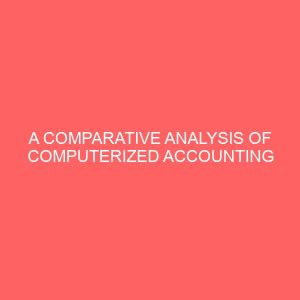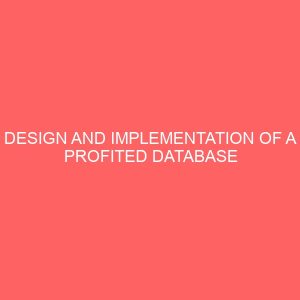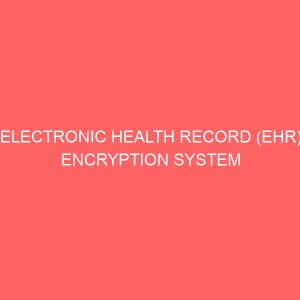Description
CHAPTER ONE
INTRODUCTION
1.1BACKGROUND OF THE STUDY
Accounting system according to an Italian monk, Luca Pacioli 1491, is the combination of personnel records and procedures that a business uses to meet its need for financial data. Financial accounting also encompasses the summary of information and presentation of periodic reports such as profit and loss statement and balance sheet. The historical firms of accounting were of different degree of sophistication according to the need and techniques of the time. This is why modern accounting is based on the double entry system and the recognition of the dual nature of each transaction and this gives a coordinate support for the control of all the transaction of a business.
Accounting system according to business dictionary is an organized set of manual and computerized accounting methods, procedures and controls established to gather, record, classify, analyze, summarize, interpret and present accurate and timely financial data for management decisions.
In spite of this, there are policies for reporting on an organization performance and current conditions. These policies increase the usefulness of report including their reliability and comparability. The policy that makes up acceptable accounting practices are determined by many individuals and groups and those policies are referred to as generally accepted accounting principles GAAP. Since accounting is a service needs and not only on those of accountants. The financial Accounting standard Board FASB is another body or group that is seen as an independent group of seven fulltime members with a large staff. This body has issued six statements of accounting concepts which help in guiding accounting standard setting. Many companies and organizations involve themselves in setting accounting rules/policies. They include investors, government agencies, politicians, unions, lenders and other business and nonbusiness organizations.
Furthermore, there are two major types of methods used in recording accounting information, such methods are manual accounting system and software accounting system or computerized accounting system.
Manual accounting system extends and includes the method of processing, recording, journalizing transactions posting to the ledgers and preparing the financial statements which provide decision makers with useful information in making decisions. These decisions relate to the allocation and use of scarce economic resources such as money, land, labour and capital. These manual accounting systems are wholly used for preparing income tax returns, reports to managers, bills to customers and other forms of providing accounting information.
In addition, with manual accounting system, accountants and managers usually inspect the documents, journal ledgers and reports in the performance of testing and verification. Transaction can be traced from source documents to journals, general ledgers, printed report etc. Subsidiary ledgers can be posted and the total can be compared with control accounts. It is visually observed by the auditors or accountants to determine whether proper books of accounts or is being followed.
Technology is a main part of our modern society and business practices. It also plays a major important in accounting as it help in reducing the time, effort and cost of record keeping while improving clerical accuracy. Technology has distinct the way we store, process and summarize large masses of data which makes accounting free to increase its field.
The origin of software could be dated back to early 1960s. Historically, emphasis in computer industry was on programming and was seen as the biggest single problem in the implementation of a computer system. Computer has the ability to add and subtract, but frequently not to multiply or divide, the computer run with relatively simple software routines.
However, this study tends to analyze the comparison between manual accounting and software accounting which are the two types of accounting system used by various organizations and companies.
1.2STATEMENT OF THE PROBLEM
In recent times, most companies and organizations have been using the manual form of operations in their accounting systems. Primarily, this manual accounting systems used to meet the organizational information requirement but this has been on consistent failure in recent times as a result of growth and diversification of business and technological advancement complexities in information technology to meet the current business demands.
Thus, companies and organizations had usually been faced with a number of problems in the use of this manual accounting system which involve lack of ability to handle sufficient volume of data in terms of speed and accuracy, insufficient data storage and retrieval system often resulting in loss of vital records, incorporating final updates, rampant report of frauds and forgeries in the use of the system, unseemliness of information which implies that information needed for effective decision making . This is repeatedly, as a result of poor retrieval and inability to collect large volume of data within the required time. All these problems include consequence in great loss of scarce resources and impeded organization growth, steadiness and advancement.
Hence, in attendance to affect these problems related with the manual accounting system and substitute it with the development of an integrated accounting software system where financial and nonfinancial accounting transaction are recorded, analyzed, retrieved, reported, interpreted, summarized and processed.
1.3OBJECTIVE OF THE STUDY
The main objective of this study is a comparative analysis of software accounting system and manual accounting system.
The study aims at ascertaining the following objectives:
1.To evaluate whether frauds and forgeries are encourage in computerized accounting system i.e. software accounting system than the manual accounting system.
2.To examine whether software accounting system can handle large volume of data than the manual accounting system.
3.To study whether the use of software accounting system increases effectiveness and efficiency in organizations or companies than manual accounting system in reducing the amount of funds lost through frauds and forgeries.
4.To examine whether software accounting system is capable of storing, retrieving, analyzing, processing, summarizing and reporting rapidly than manual accounting system.
5.To show the operational and reporting system in both the manual accounting system and software accounting system.
1.4RESEARCH QUESTION
The course of this research has picked up some interesting enquires and
discussions which centered more on a comparative analysis of software accounting and manual accounting system in two companies Nigeria Breweries Plc. and Africa Petroleum Plc in Enugu State.
The following questions are put forward for the purpose of the study:
i.What are the measures taken to ascertain the extent to which fraud and forgery can be prevented and controlled using either of the accounting system
ii.Can software accounting system handle large volume of data more than the manual accounting system
iii.How effective and efficient is the use of software accounting system or manual accounting system
1.5RESEARCH HYPOTHESES
Here the following hypotheses were formulated, tested and validated in the study.
Hypothesis One
H0: frauds and forgeries are not encouraged with the use of software accounting system than manual accounting system








Reviews
There are no reviews yet.